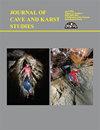美国西弗吉尼亚州干洞方形苏打吸管的形成与演化
IF 0.5
4区 地球科学
Q4 GEOSCIENCES, MULTIDISCIPLINARY
引用次数: 0
摘要
一种全新的方解石钟乳石,类似于苏打吸管,但外部呈方形,最近在美国西弗吉尼亚州的干洞中被观察到。虽然过去曾描述过具有一个或多个平面边(三角形到六边形横截面)的罕见洞穴石,但这是第一个报道的地面钟乳石样洞穴石具有菱形平行六面体结构的例子。在洞穴中观察到十几个例子。建议的遗传机制允许非典型生长的平行六面体似乎是由几个边界条件控制,通常排除他们的发展。受下降水汽中方解石结晶特性和收集(已破碎)样品形态的限制,我们假设进料管内初始过饱和度非常低,加上相对快速的滴水,导致正常单晶方解石苏打吸管的生长,其C轴与管轴和圆形截面一致。只有当水膜在吸管的外表面流动时,方解石才有可能在汽水吸管的外部沉淀。正常情况下,这种外部流动将导致管状吸管迅速转变为典型的多晶锥形钟乳石。但在这种情况下,外部进料膜是最低限度的过饱和甚至不存在,这减缓了苏打秸秆原有单晶结构的外延生长,抑制了方解石晶体的径向(多晶)生长。这导致在静止条件下,稻草转变成平行的,双晶方解石晶体堆叠形成锥体钟乳石,横截面为菱形,整体锥形角<2°。在最极端的情况下,苏打吸管会逐渐变成一个看似正方形的单晶平行六面体。必要的边界条件包括汽水吸管上总是稀缺的过饱和/不饱和流动的非平稳分布,与简单饱和周期交替。锥形、锥体和平行六面体钟乳石发育的控制因素似乎是渐尖角。这个刚刚概述的遗传机制是推测性的,应该进行实验测试。最后,在少数收集到的方形吸管样本中,这种形状通常被另一个发展步骤所掩盖,这个步骤可能在它们已经断裂时开始活跃。这个最后阶段的特点是外延水的过饱和突然增加,这导致了一层多晶方解石的沉积,至少部分地掩盖了洞穴石的单晶结构。本文章由计算机程序翻译,如有差异,请以英文原文为准。
Genesis and evolution of the square soda straws of Dry Cave, West Virginia, USA
A completely new (sub)type of calcite stalactite, similar to a soda straw but showing an external square shape, has been recently observed within Dry Cave, West Virginia, USA. Though rare speleothems with one or more planar sides (triangular to hexagonal cross sections) have been described in the past, this is the first reported example of a subaerial stalactite-like speleothem with a rhombic parallelepiped structure. More than a dozen examples were observed in the cave. The suggested genetic mechanisms allowing the atypical growth of a parallelepiped seem to be controlled by several boundary conditions that normally preclude their development. Constrained by the specifics of calcite crystallization in descending vadose waters and the morphology of collected (already broken) samples, we hypothesize that an initial very low supersaturation within the feeding tube, together with relatively fast dripping, causes the growth of a normal monocrystalline calcite soda straw with the C axis coincident with the tubular axis and circular cross sections. Calcite precipitation on the outside of the soda straw is possible only if there is a water film flowing on the straw’s external surface. Normally, this external flow will cause the rapid transformation of a tubular straw into a typical, polycrystalline conical stalactite. But in this case, the external feeding film is minimally supersaturated or even absent, which slows epitaxial growth over the pre-existing monocrystalline structure of the soda straw and suppresses radial (polycrystalline) growth of calcite crystals. This induces, in stationary conditions, transformation of the straw into parallel, twinned calcite crystals stacked to form a pyramidal stalactite with rhombic cross sections and an overall tapering angle of <2°. In the most extreme cases, the soda straws are gradually transformed into a seemingly square monocrystalline parallelepiped. The necessary boundary conditions involve a non-stationary distribution of always scarce supersaturated/undersaturated flow over the soda straw, alternating with periods of simple saturation. The controlling factor for the development of conical, pyramidal, and parallelepiped stalactites seems to be the tapering angle. This just outlined genetic mechanism is speculative and should be experimentally tested. Finally, in the few collected samples of the square straws, this shape is often masked by another development step, which probably became active when they were already broken. This final stage was characterized by a sudden increase in supersaturation of epitaxial water, which induced the deposition of a thin layer of polycrystalline calcite that masks, at least partially, the monocrystalline structure of the speleothem.
求助全文
通过发布文献求助,成功后即可免费获取论文全文。
去求助
来源期刊

Journal of Cave and Karst Studies
地学-地球科学综合
CiteScore
1.90
自引率
0.00%
发文量
6
审稿时长
>12 weeks
期刊介绍:
The Journal of Cave and Karst Studies is a multidisciplinary journal devoted to cave and karst research. The Journal is seeking original, unpublished manuscripts concerning the scientific study of caves or other karst features. Authors do not need to be members of the National Speleological Society, but preference is given to manuscripts of importance to North American speleology.
 求助内容:
求助内容: 应助结果提醒方式:
应助结果提醒方式:


